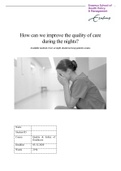How can we improve the quality of care
during the nights?
Avoidable medical errors at night should not keep patients awake.
Name
Student-ID
Course Quality & Safety of
Healthcare
Deadline 03-12-2020
Words 2194
, Introduction
It was disorientating. It totally messes up your body clock. […] The most difficult
thing is that there's no fixed times, […] so every day is different. It's difficult to have a
social life, and your body can't adjust. […] You feel very unwell and jetlagged. I could
barely talk sometimes. (General practitioner, edited from: Cocozza, et al. 2014)
Up here you read the experience of a general practitioner working night shifts. While most
people are peacefully asleep at night, thousands of healthcare workers need to keep our health
system going. Working night shifts can have an negative impact on physical, psychological
and psychosocial health (Brooks et al., 2020). For example, nurses who work night shifts have
an increased risk for certain forms of cancer, diabetes and obesity. However, this varying
sleep rhythm is not only related with personal health problems, but also with performance (Di
Muzio et al., 2020; Brooks et al., 2020). Healthcare professionals are experiencing stress and
dealing with reduced alertness which may increase medical errors. Therefore, the quality of
care in the night differs from the day. This affects the patient safety, a fundamental principle
of healthcare which is necessary to provide high quality of care (WHO, 2017). Improving the
patient safety at night could be an important step for better quality of care. This leads us to the
following question that will be central in this paper: What differences between day and night
shifts are causing unequal quality of care and what can organisations do to improve patient
safety during the night?
This paper will be build up by four sections. The first one is the conceptual framework, where
relevant concepts and theories are explained. After that, in the analysis, these concepts will be
used analyse the problems during the night shifts. Followed by the conclusion were an answer
on the main question will be provided. Finally, in the discussion we will look at the broader
societal issues.
Conceptual framework
To improve the quality of care during night shifts, we need to understand the underlying
mechanisms of what is happening. Quality improvement in healthcare is complex and
multidimensional. According to Bate et al. (2008) there are six cohesive average challenges
organisations have to deal with while improving the quality of care. To provide an answer on
the research question, this paper will value the quality of care during night shifts from the
structural, political and educational challenge. The structural challenge is about creating good
structures to organize quality improvement: organizing, planning and coordinating. The
educational challenge is about creating and maintain a learning process that fosters continuous
quality improvement. The last one, the political challenge, is about the power and politics of
an organization (Bate et al., 2008).
For a better understanding of why things go wrong in the night, we are using four theoretical
concepts. The first one is related to what and how we define the quality of care. In the
contemporary healthcare system, there is lots of focus on external measurement. For example,
performance indicators are used to measure the quality of care. Developments like this come
along with unintended consequences like decoupling. Bromley & Powell (2012) introduced





